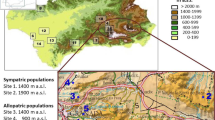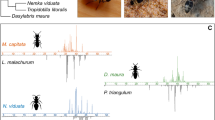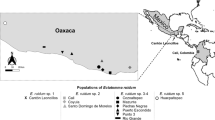Abstract
The chemical signatures on the cuticles of five common Myrmica ant species were analysed (49 colonies of M. rubra, M. ruginodis, M. sabuleti, M. scabrinodis and M. schencki), each ant being the specific host of one of the five threatened European species of Maculinea butterfly. The cuticular hydrocarbon profile (based on the relative abundance of each chemical) of each ant species was highly distinctive, even between the morphologically similar species M. sabuleti and M. scabrinodis. There was no significant difference in the chemical profiles of workers and larvae from any colony. Nor was there much pattern in the intraspecific variation: colonies from the same populations were significantly, but only slightly, more similar to each other than to colonies from distant populations. M. rubra showed remarkably little variation between populations sampled widely from northern Russia, Ukraine, Scotland and southern England. The data were compared with published profiles of M. rubra and two North American Myrmica species, and with a quantitative reanalysis of data for Maculinea rebeli caterpillars. We conclude that the hydrocarbon profiles of Myrmica species are sufficiently and consistently different for chemical mimicry to explain the pattern of host specificity recorded for the European Maculinea butterflies. The optimum strategy for chemical mimicry in each of the two life-styles of Maculinea larvae is discussed: we suggest that predatory species might benefit from mimicking the median profile of their model whereas the "cuckoo" species would benefit when variation between siblings encompasses a large range of the variation recorded within a local population of the model species.
Similar content being viewed by others
Author information
Authors and Affiliations
Additional information
Electronic Publication
Rights and permissions
About this article
Cite this article
Elmes, G., Akino, T., Thomas, J. et al. Interspecific differences in cuticular hydrocarbon profiles of Myrmica ants are sufficiently consistent to explain host specificity by Maculinea (large blue) butterflies. Oecologia 130, 525–535 (2002). https://doi.org/10.1007/s00442-001-0857-5
Received:
Accepted:
Published:
Issue Date:
DOI: https://doi.org/10.1007/s00442-001-0857-5




